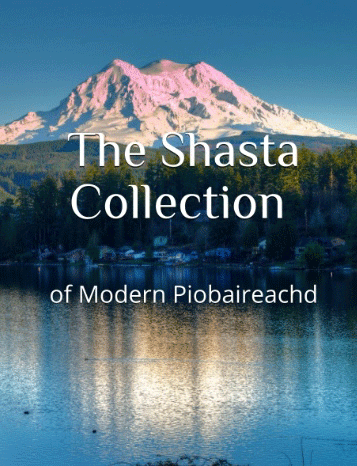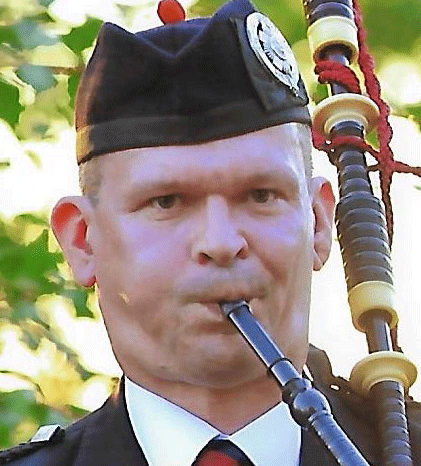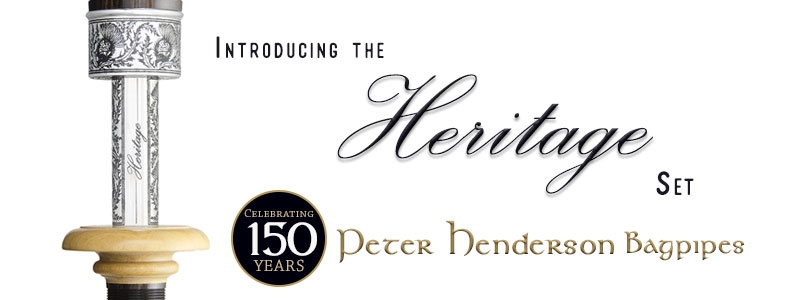
On being asked to review this recent publication I realised that I have stated many times in recent years that I am a supporter of modern piobaireachd composition. With further reflection the realisation dawned that many of the tunes in my repertoire I considered modern were approaching fifty years of age. I was facing an opportunity to take a look at much more recent compositions.
The book reproduces the scores of thirty one piobaireachd submitted over the past four years to the Shasta Piping Society’s composing competition by over twenty composers from eight countries. Getting on for half the tunes received prizes and the remainder are described as ‘notable extras that didn’t quite make the prize list, and three specially commissioned pieces’.

By Roddy Livingstone
A feature of the book, which I particularly liked, were the comprehensive composer biographies and notes on the origins of the names and inspirations behind the tunes. Whilst the book is produced in A4 ‘portrait’ format, it is confusing that the majority of the scores are printed in ‘landscape’ orientation. This removes the ability of the reader to simply place the book on a music stand and have a run through the tunes on the pipe or the ‘goose’ (my preferred way to assess a new piobaireachd without the interruptions to flow and phrasing which accompany a similar exercise on the chanter).
That minor irritation aside, the scores are clearly printed and laid out. Abbreviations used are, more or less, similar to those we are familiar with in the current Piobaireachd Society series or Kilberry Book, the exception being the triplet movement represented by three short lines through the perpendicular tail of the semi-quaver rather than the underscores generally used. They are certainly easy to follow.
[wds id=”2″]
Having spent a little time studying the construction of the tunes, it was interesting to note a variety of styles employed ranging from straightforward ‘primary’ through to ‘irregular’. Some composers choose to show a time signature whilst others do not. I am increasingly of the opinion that the absence of such notation is of little importance and does little to assist the piper in finding the pulse and scansion to the phrasing.
Of the tunes themselves, I found myself very much agreeing with the merit attached by the judges in awarding places. There are certainly some original melodic lines in evidence but I was also struck by the feeling that parts of certain tunes sounded very similar to established and better known pieces of our repertoire. Perhaps I am being a touch over critical here – after all we only have nine notes and unconscious influence is difficult for an aspiring composer in any genre of our music to avoid.
Another common thread running through a number of the tunes published is a feeling that some pieces are slightly overly developed whilst others leave the impression of a work in progress – just missing the final element to make them complete.
I am mindful that the previous generation of successful composers of ceòl mòr (Pipe Major Donald MacLeod, Captain John A. MacLellan, Archie Kenneth, Dugald MacLeod of Portree etc.) sometimes spent years altering and editing their tunes, adding or removing as the mood changed and they analysed and reflected on their creations. Perhaps some of the composers will re-visit and refine these tunes in the future in a similar way when not distracted by looming competition entry closing dates.
Lecturing to the Piobaireachd Society’s ‘Army Class’ (now the ASBM&HD Pipe Major’s course) around 1950, Archibald Campbell of Kilberry stated, ‘Efforts have been made, but it is safe to say that nothing in the shape of a piobaireachd has been composed in the last hundred years which a piping musician of the ability and knowledge of your instructor [Pipe Major William Ross] would bother to attempt to play’.
Having studied piobaireachd with Archibald Campbell’s son James for twenty five years I find it slightly uncomfortable to disagree such a pillar of my piping lineage, but disagree I do. This book is clear evidence of contemporary meritorious piobaireachd composition.
Whether these tunes will grow in popularity and be heard in competition or at recitals remains to be seen. However, the Shasta Piping Society and the East Ayrshire Pipe Band Academy have provided a valuable service in making these modern piobaireachd available to the piping community.
- The Shasta Collection of Modern Piobaireachd is available here.


















